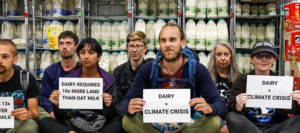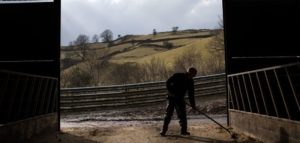Planning the Christmas lunch yet? If you are vegan you’ve doubtless got tofu in there somewhere, perhaps served up with a sauce made piquant with a tablespoon of smugness. After all, going “plant-based” will save the planet from climate change, whereas we meat-eating ignorati are murdering you, and nature, and the air we breathe. Britain’s very own Climate Tsar, Alok Sharma, when asked on BBC Newscast recently about his family’s personal contribution to fighting global warming, flailed around before playing the get-out-of-jail-free, no-meat card.
Is it not curious how carnivorism is subject to endless negative news and analysis, whereas the same rules do not apply to vegan food? As a keeper of livestock in sustainable, ethical, regenerative farming systems, may I say I find it hypocritical to be lectured by those who fly on polluting jets to Egypt, Mexico, Peru and other places I will never see? Has the COP jamboree not discovered Zoom yet? So, for once, let us turn the dinner tables, put vegan food under the knife and fork, and examine its impact on the environment. Where better to start than with tofu?
An ancient, soya-based ingredient in Asian cuisine, tofu came to the West with stoned returning hippies, and was an obscure item in Whole Food shops until the early 21st century, when it started to appear on the shelves of every middle-class supermarket as the meat-free, climate-healing superfood. Suella Braverman’s recent rant about “Guardian-reading, tofu-eating wokerati” was not without its truth; tofu is as much a right-on political choice as a potential ingredient in tonight’s family dinner.
Tofu, for those unacquainted with the stuff, is curd made from soybeans that have been soaked in large tanks and churned into a slush, which is then heated, filtered and coagulated into slabs, before being chopped up, packaged, and pasteurised. All these steps require a lot of carbon dioxide-emitting energy.
The amount of soybeans grown in the UK is negligible (3,000 tons in 2019: our isles are insufficiently warm for the crop), meaning the soybeans imported for any national tofu-maker come with enough travel miles to get them from Japan, say, or the US. The Tofoo Co. might come over all artisanal — their tofu is made “int Yorkshire”, as they declare on their website — but the raw product is shipped from Canada and Italy.
Then you have the packaging. Tofu is sloppy, wet stuff, invariably sold wrapped in thick plastic you could use as kids’ shoes at the beach. Selflessly, your author, in the interests of “method research”, ate 200g of Bjorg smoked tofu; the plastic packing weighed 10g, actually measurable on analogue kitchen scales.
The Tofoo Co., meanwhile, earnestly informs us: “We don’t pack ours in a ready meal tray in water (the only other way we know tofu can be packed) as we think thermoforming gives a MUCH BETTER, less soggy product, that is ready to eat.” (Amusing, no? They admit tofu is inevtiably soggy, even if you can get less soggy versions.) But “thermoform packaging”, lovely as it sounds, is plastic, and plastic is derived from fossil fuels. The production process involves heating plastic until it is pliable — can you imagine the kilowats of energy required? And extraordinarily, you cannot recycle Tofoo’s wrapping.
Despite all this, if you run “tofu” through the BBC’s climate change food calculator, you will be informed that your “personal consumption” accounts for 12kg to your annual greenhouse gas emissions, on the basis of two servings a week. Two servings of beef come out at a whopping 604 kg per year. A clear win for tofu? Well, no.
The BBC calculator is based on work by Oxford-based environmentalist scientist, Joseph Poore. He who appeared in a promo for the “Go Vegan for Lent” campaign, organised by pressure group Million Dollar Vegan. Poore’s claims to have calculated the universal carbon footprint of an entire food type based on air miles and packaging, as well as production, are nonsensical: it is impossible to do so, given the diversity of packaging and the global nature of distribution. (Were your onions loose and local, or from Spain wrapped in a nylon net?)
Worse, climate change calculators based on crude protein or calories, such as the BBC’s, are flawed in a way that would be amusing if the consequences were not tragic. Tofu has a seemingly respectable 10g of protein per 100g — but not all protein is equal. For humans, soy protein is less digestible than meat protein. In other words, you have to eat proportionately more tofu to get the same protein allowance. Tofu also has significantly less riboflavin, niacin, pantothenic acid, vitamin B6 and vitamin B12 than meat. To make up these deficiencies, tofu-eaters have to either take supplements, or eat additional food — both of which produce greenhouse gases. The Vegan Society, for instance, encourages any breastfeeding meat-free mothers to take supplements of B12, iodine, vitamin D and omega-3, as well as to increase their calcium intake.
The deficiencies of tofu go beyond its nutritional value. The stuff is tasteless: although venerated by vegans, in classic Asian dishes such as Mapo tofu, the tofu is actually mixed with meat in the hope it will imbibe meat’s tastiness. Tofu is used as filler. Nobody ever said: “I could murder a nice juicy lump of tofu.” The result of this tastelessness is that consumers in the US throw away 30.5% of all tofu purchased; this food waste increases its environmental impact by a whopping 43.9%. The figure for meat thrown away is 20%.
By now you may understand why the Rothamsted Institute’s Dr Graham McAuliffe, an expert on modelling the environmental impacts of food over their lifecycle, has concluded that:
“If you look at tofu, which is processed so there is more energy going into its production, when you correct for the fact that the protein in it is not as digestible compared to the meat-based products, you can see that it could actually have a higher global warming potential than any of the monogastric animals. To get the same amount of protein, tofu is worse.”
On and on goes the list of tofu’s environmental sins. While it is true that most soy grown in Brazil goes to animal feed, some makes its slippery way into the human food chain, and thus into tofu — so add deforestation of the Amazon to that list. If you’re eating it in the UK, tofu from the tree-felled Amazon would cost you double the amount of CO2 than chicken farmed on these isles.
According to the dear old BBC food calculator, “even the most climate-friendly meat options still produce more greenhouse gases than vegetarian protein sources”. The same lie is broadcast by groupthink governments and the vested interests of the Big Vegan food industry. It’s a lie because you can buy meat from a grass-based, carbon-neutral provider. Indeed, you can buy meat from farmers who, due to sensitive, sustainable pasture management, are sinking more carbon dioxide than their operations emit. You can buy meat wrapped in paper from a butcher, meat which comes from a carbon-neutral factory.
Also, cows produce manure, which feeds insects: an organic, outdoor cow feeds more than 2 million insects a year, dramatically aiding biodiversity as well as the soil. Manure can reduce, or even eliminate, the need for artificial fertiliser, which is responsible for no less than 2.1% of global GHG emissions. Most soy, meanwhile, is chemically drenched. Indeed, the story of contemporary soy production is the biography of agri-business giant Monsanto and its patented, controversial weed-killers.
Back in the mid-Nineties, Monsanto’s chemists genetically engineered soy to be immune to sprayings from Roundup, a herbicide supplied by… Monsanto. The Roundup Ready soybean could effectively only be grown with applications of the company’s glyphosate weed-killer. However, weeds being weeds proved resistant to Roundup. So in 2015, Monsanto began producing soybean seeds, branded “Roundup Ready Xtend”, engineered to tolerate dosings of both glyphosate and another chemical, dicamba.
Let’s be clear: genetically modified soy, specifically developed to withstand one Earth-polluting chemical, was sprayed, when yield dwindled, with another Earth-polluting chemical. Anything sprayed with both Roundup and dicamba certainly died — including soy not grown from Monsanto-supplied beans. Farmers not using them soon discovered such was the drift from the volatile dicamba that if they were within half a mile of other farmers using it, their crop was impacted.
According to the US Environmental Protection Agency, there were 3,300 dicamba “incidents” in 2019 alone. Faced with a choice of no crop or Monsanto crop, US soy farmers shifted en masse to being Monsanto clients. The report of the US Center for Food Safety on soy, Monsanto, and the “dicamba debacle” makes for sobering reading:
“Sprayed in large quantities over-the-top of resistant crops in the summertime heat, dicamba vaporised and drifted long distances to cause enormous damage across the landscape… Pesticide expert Andrew Thostenson of North Dakota State University said it was unlike anything that ‘has ever happened in the history of pesticide use in this country’.”
Today, around 94% of the world’s soy is genetically engineered, mostly to be resistant to Monsanto’s Roundup. Alas, as Roundup’s efficacy diminishes, the more it gets sprayed; soybean farmers are currently doubling glyphosate applications per season. Soybeans produced on commercial farms in the USA, Brazil and Argentina accumulate an estimated 2,500–10,000 metric tonnes of glyphosate per year. The adverse effects of glyphosate and dicamba on the environment only begin with the destruction of soil microflora, bee colonies, and aquatic organisms.
Anybody who believes that tofu is a green alternative to meat has no idea how industrialised soybean farming works. Anybody who believes it has a light carbon footprint needs to look again. The soybean is the most environmentally dangerous agricultural crop in the world, and the production of tofu is a drain on our precious resources. The thermoform packets of tofu on the shelf of your local supermarket ought to come served with a warning: this product is harmful to the Earth’s health.
Disclaimer
Some of the posts we share are controversial and we do not necessarily agree with them in the whole extend. Sometimes we agree with the content or part of it but we do not agree with the narration or language. Nevertheless we find them somehow interesting, valuable and/or informative or we share them, because we strongly believe in freedom of speech, free press and journalism. We strongly encourage you to have a critical approach to all the content, do your own research and analysis to build your own opinion.
We would be glad to have your feedback.
Source: UnHerd Read the original article here: https://unherd.com/




